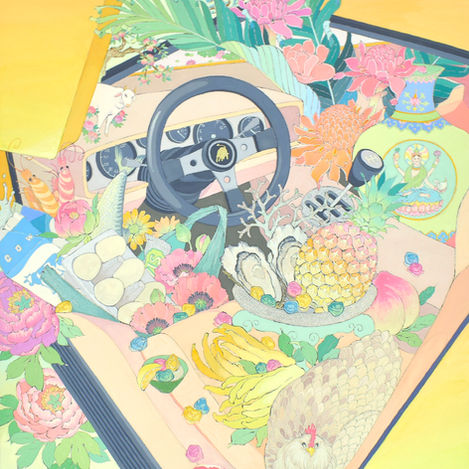
SHOICHI OKUMURA
BIO
Shoichi Okumura was born in BeiJing, China in 1989 to a Japanese father and Chinese mother. A few years later his family moved to Tokyo, Japan, where the artist lives and works today. Shoichi continues to draw inspiration from both his birth country and Japan by employing mineral pigments on silk canvases.
"My works are not painted with acrylics, but with iwa-enogu (mineral pigment), traditional Japanese mineral pigments. These pigments are made by grinding natural minerals and have a distinctive texture and vivid coloration. They are the same types of pigments used by Edo-period artists such as “Itō Jakuchū” and the “Kano-Ha” painters." Shoichi brings these traditional methods into the 21st century by blending ideas of nature with modern subjects and man-made industrial objects. Through the use of multiple perspectives and scenes, ethereal worlds appear to float around within each other, drawing the eye to every inch of his compositions and back again. Shoichi received his MFA in painting from Tama Art University in 2017. He has participated in numerous solo exhibitions and art fairs in both Taipei and Tokyo. This will be Shoichi's first showing in the United States and will debut work at this year's iteration of the Seattle Art Fair with Hall Spassov.
STATEMENT
Walking through the “園林/YuanLin”, one notices here and there the inclusion of “盆景/BonKei” and “太湖石/Taihu stones." While these are small separate worlds placed within the “園林/YuanLin”, the garden itself serves as a condensed depiction of real scenes or imagined paradises. In this regard, it is no different from the similarly condensed small separate worlds.
This structure is not only found in gardens but also in paintings such as those depicting the landscapes of the Northern Song Dynasty or mandalas, as well as in architectural structures like courtyard houses or earthen buildings, and in stories such as "Dream of the Red Chamber," where the notion of a condensed small separate world, akin to a nested paradise, is often expressed.
Drawing from this nested structure, a contemporary utopia is portrayed by combining elements of the fictional "tropical" and characters as analogies for landscapes, echoing the concept of a modern utopia.





